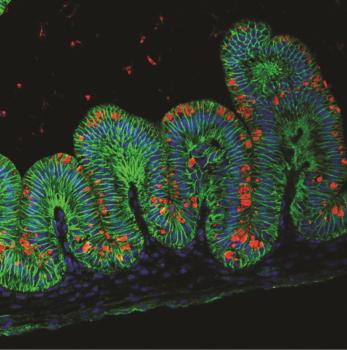
Researchers say the miniature human stomach - called a human "gastric organoid" - provides a tool in which to study an array of diseases, including stomach cancer and metabolic syndrome.
Image credit: Kyle McCracken
Recently, a team of researchers reported on another study from Cincinnati Children's Hospital Medical Center detailing the creation of fully functioning, miniature human intestines.
After successfully transplanting these miniature intestines - referred to as intestinal "organoids" - into the kidneys of mice, the researchers claimed their findings could one day lead to the creation of personalized human intestinal tissue for the treatment of gastrointestinal diseases.
This latest study was published in the journal Nature.
For this research, the researchers used human pluripotent stem cells (hPSCs) - mature human cells that have the ability to change into any cell type in the body - to grow a miniature human stomach, or "gastric organoid."
Until this study, no one had generated gastric cells from hPSCs. In addition, we discovered how to promote formation of 3D gastric tissue with complex architecture and cellular composition.
Understanding stomach formation and the early stages of disease
Before they could grow the gastric organoids, the research team needed to determine exactly how the stomach is formed during embryonic development. Reaching this point involved 2 years of analyzing previously published research on the issue - which there was very little of - and conducting a series of experiments.
Once understood, the researchers applied the stomach-formation processes to hSPCs in a petri dish, encouraging them to turn into miniature human stomachs.
The researchers say the 3D human gastric organoids - which are around 3 mm in diameter - were formed within 1 month.
The research team then used the organoids to study infection of the stomach by bacteria called Helicobacter pylori - known to cause peptic ulcer disease and stomach cancer.
The researchers found that within 24 hours of introducing H. pylori to the gastric organoids, biochemical changes occurred. Specifically, the researchers witnessed a replication of the early stages of gastric disease. This included the fast spread of infection in epithelial tissues and the activation of c-Met, a cancer gene.
But these discoveries are only the beginning. The researchers say the human gastric organoids pave the way for new drugs, provide a model to identify the early stages of stomach cancer and allow researchers to assess the mechanism underlying obesity-related diabetes.
Furthermore, this study allowed the researchers to pinpoint the drivers behind normal stomach formation in humans, which makes it easier to determine what happens in the event of impaired stomach formation.
The researchers add:
"Moreover, this is, to our knowledge, the first 3D production of a human embryonic foregut and represents a promising starting point for the 3D generation of other foregut organ tissues including fundus, lungs and pancreas."
Earlier this year, a team of researchers reported on a study in which researchers claimed to have identified four distinct molecular subtypes of stomach cancer, which they said could pave the way for personalized treatments for patients with the disease.
No comments:
Post a Comment